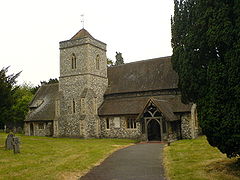Harpsden
| Harpsden | |
|---|---|
 Parish Church of Saint Margaret |
|
| Harpsden shown within Oxfordshire | |
| Area | 8.77 km2 (3.39 sq mi) |
| Population | 560 (2001 census) |
| • Density | 64/km2 (170/sq mi) |
| OS grid reference | SU7680 |
| • London | 34 miles (55 km) |
| Civil parish |
|
| District | |
| Shire county | |
| Region | |
| Country | England |
| Sovereign state | United Kingdom |
| Post town | Henley-on-Thames |
| Postcode district | RG9 |
| Dialling code | 01491 |
| Police | Thames Valley |
| Fire | Oxfordshire |
| Ambulance | South Central |
| EU Parliament | South East England |
| UK Parliament | |
Harpsden is a rural and semi-rural village and civil parish immediately south of Henley-on-Thames in South Oxfordshire, Oxfordshire, England. Its scattered centre is set 0.5 miles (0.80 km) from the east border which is the River Thames, marking a short boundary with Berkshire. The parish extends 5 miles (8.0 km) inland and borders Rotherfield Peppard to the west, that is, next to its main sections of woodland in the southern extreme of the Chiltern Hills including an SSSI area of ancient woodland. The village has neither railway station nor shops, but has the main road from Reading to Henley, both of which have grown substantially since World War II into centres of trade, education and general meeting places, such as by their increased number of cafés and restaurants.
Remains of a Roman villa have been found about 0.5 miles (800 m) southwest of the village.
In the 11th century during the reign of King Edward the Confessor the manor of Harpsden belonged to Wigod, the thegn of Wallingford. After the Norman conquest of England Harpsden became part of the Honour of Wallingford.
The Church of England parish church of was originally late Norman, as evidenced by the piscina, font and a blocked doorway that survive from this period. The current windows in the nave and chancel were inserted in the 14th century, and a stone effigy of a knight dates from the same period. In 1848–54 the Gothic Revival architect Benjamin Ferrey lengthened the nave and added the north aisle and tower. In 1879 the architect Henry Woodyer restored the chancel.
...
Wikipedia

